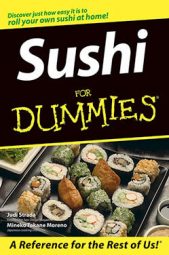Keep sushi dry goods in a cool, dry, dark pantry or cupboard —as for all dry food ingredients. Sushi dry goods quickly deteriorate if exposed to heat, moisture, or light. Most of these sushi dry goods are best used within six months of opening, and should be refrigerated or frozen after opening:
Dashi konbu (dried kelp): Resembles broad, leathery, wrinkly ribbon. The darker green the leaves, the better the quality. Dashi konbu is often coated with a natural, white powdery substance that blossoms out in the drying process.
Katsuobushi (dried bonito flakes): Looking like pale salmon-colored wood shavings, katsuobushi are in fact shaved flakes of cooked, dried bonito (a type of tuna).
Matcha (powdered green tea): A special tea used in the Japanese tea ceremony. This powdered tea also makes a dynamite seasoning when combined with salt or sugar.
Nori (sheets of dried seaweed): Seaweed that’s been processed into thin sheets. It’s aromatic and crisp, like a potato chip — the result of drying, not frying. The best-tasting nori is dark green verging on black. (Reddish brown nori is often old and not desirable.)
Shiitake mushrooms, dried: Filled with fragrance and a highly desirable meaty flavor. Soaking dried shiitake mushrooms in cool water results in plumper, smoother, and softer reconstituted mushrooms than when done in hot water. The caps are eaten, and the stems can be discarded or saved for stock.
Tempura mix: Tempura batter mix makes crispy-perfect tempura.
Wakame (dried seaweed): Wakame is a subtly sweet, thin, deliciously smooth, and chewy seaweed that’s a dream to eat. Dried, it looks like black, curly shreds of confetti, but when soaked it multiplies many times in size into green wavy ribbons. Avoid dried reddish brown wakame because it may be old.

